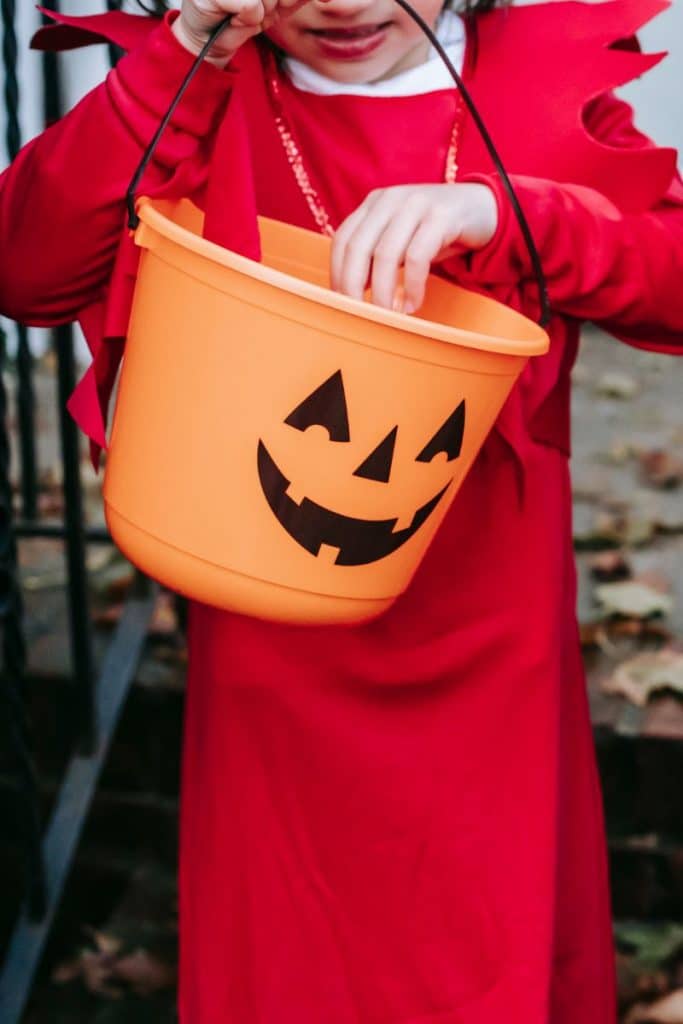How to handle candy for kids – Don’t ruin Halloween!
A dietitian shares tips for how to handle candy for kids at Halloween and create a healthy relationship with sweets for your kids.
As a child, I remember the excitement of squishing my oversized Halloween costumes underneath a winter coat and the energy buzz of hearing the “ding dong” of doorbell after doorbell. And hoping that each house would deposit a full-sized candy bar into my plastic Halloween pumpkin.”But now, as parents, many of us dread Halloween if it means letting our kids eat a pillowcase full of sugar.
What can we do to prevent a child from candy overload or becoming ‘addicted’ to sugar? It might not be what you’re thinking! In this post, I’ll share some tips for managing Halloween candy to promote a healthy relationship with sweets for your kids.
Effects of sugar on children’s behaviour and nutrition – is it really that harmful?
Foods high in sugar (like Halloween candy!) can fill your child up, and don’t provide any vitamins or minerals they need to be healthy and taste delicious! Sure, there may be other health risks to a diet high in sugar (like cavities), but I won’t go into them. I don’t want you to be anxious. Because the more anxious you are, the more likely you’ll restrict your child’s intake tightly.
And the problem with having a “sugar-free” child is that the more you restrict something, the more they want it. Having tight boundaries around candy intake doesn’t allow them to learn to self-regulate it and can lead to cravings. So don’t be the candy or food police…
Does sugar cause hyperactivity?
It’s well documented in research that sugar does not cause kids to be hyper. Then why does your child go wild at parties with lots of sugar?
Their wild behaviour has more to do with the environment than food. They’re surrounded by lots of other kids, having a blast! It also has to do with parents’ expectations. If parents think sugar causes their children to be hyper, they rate their children as more hyper. Even after having a placebo drink which did not contain any sugar!
Ok, but isn’t sugar addictive?
Is sugar addictive?
Are you afraid your child has an obsession with candy? Will they become a sugar addict if you let them eat lots of sweets?
This review study on sugar addiction states: We find little evidence to support sugar addiction in humans, and findings from the animal literature suggest that addiction-like behaviours, such as bingeing, occur only in the context of intermittent access to sugar. These behaviours likely arise from intermittent access to sweet-tasting or highly palatable foods, not the neurochemical effects of sugar.
So, binging on food or sugar happens not because your child has unlimited access and is addicted. It happens because your child has limited access—perhaps the exact opposite of what you thought.
How to handle candy for kids at Halloween
Have a good dinner (including some protein and veggies) before going trick or treating. This way, your child has some healthy food filling their tummy in preparation for the sugar rush. A tummy full of gummies, chocolate, and nothing else will not feel good later!
As for how to dole out these treats, it’s best to let your kid choose how much to eat within some guidelines. If you follow feeding guru Ellyn Satter’s advice, she suggests letting your child eat as much as they want on Halloween night and the next day.
After that, offer the candy only at a meal and snack. Add a piece or two to their lunch kit. When they get home from school, let your child choose how much to eat at snack time (but still offer other foods). Besides giving your child some control over how much they eat, the candy will be gone more quickly!
If your child is ok sticking to these rules, let him keep his own candy stash. Now that my kids are older (my youngest is 8), I will let them keep their candy in their rooms.
This accomplishes Ellyn Satter’s recommendation of “Work toward having your child’s being able to manage their own stash. To let them learn, keep your interference to a minimum.” If they can’t manage it then you can keep the candy and stick to the guidelines of only at snack and meal time.
I was always allowed to keep my own candy stash and had it under my bed for MONTHS! It’s really not as appealing if it’s unlimited. But when it is offered in limited portions, you might find your child coveting the candy and searching for your hiding spot!
Alternatives to letting your child eat a pillowcase full of candy
Halloween is a great learning opportunity and time to disempower sweet treats. If you don’t like your child having their whole stash and I can’t convince you – at least let them pick out their favourites.
If you have a toddler or preschooler, they may not be quite as aware of the unlimited candy feature of Halloween. And just like the fun of going door to door dressed up. So, buy your child a small plastic pumpkin to fill. You’re done trick or treating once it’s full (if they even last that long!).
You could also trade candy for money. Either you can pay your child or some dental offices do a candy “buy back” and exchange your candy for money. I would ONLY suggest this if it excites your child, and they would rather have the money than the treats they are exchanging. Some kids are very money-motivated.
When my kids were really young and loved toys more than candy, we had a visit from the “Switch Witch” or “Candy Fairy” – similar to the tooth fairy. We’d put most of the candy (after picking out some faves) on Halloween night, and the switch witch comes and leaves a toy in exchange. I remember my son loved it! But it certainly wouldn’t fly now – my kids prefer the candy, so I let them keep it.
Long-term sweet management for kids
The goal of managing sweets and treats is to set your child up to have a healthy relationship with food. So they can forever enjoy a reasonable amount of sweets without feeling guilty.
Here are a few ways to do this:
- When you have dessert, serve it with dinner. This prevents it from being the bribe for eating all of their veggies/dinner! Remember, we’re trying to normalize sweets and not put them on a pedestal.
- Offer sweets as a snack a few times a week, and your child can choose how much to eat. Once, when I was a child, I ate so many chocolates that I puked. Did I ever do that again? No! Sometimes, the best lessons are natural consequences.
- Call food what it is. It’s not “treat food” or “fun food.” It’s a cookie or cake. Want to know more about how to disempower dessert? Check out my Global interview here.
There you go! You’re an empowered parent now, have a plan for Halloween candy and can ditch the paranoia.
As a bonus, click here to grab 14 free Halloween snack recipes for your kids!
Jennifer House is a Registered Dietitian, author & mom of 3. From Baby-led weaning to picky eating and meal planning, she helps you to make feeding your family easier
Founder of First Step Nutrition | Registered Dietitian Nutritionist
Jen believes raising happy, well-nourished eaters who have a healthy relationship with food doesn't have to be a battle! She is an author and speaker with 18 years of experience specializing in family nutrition and helps parents teach their kids to try new foods without yelling, tricking, or bribing.








No Comments